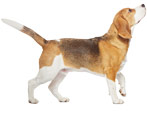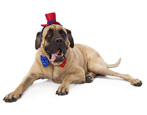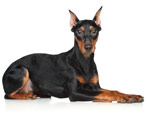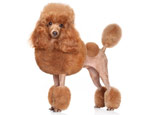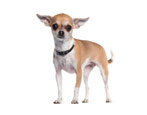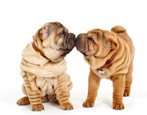Maybe someone paid attention to cute little dogs accompanying employees at the airports? Similar at the same time to the fox and the wolf, they are employees of aviation security, although they look completely harmless. This latest breed of dog, officially recognized only in 2018, is called a hut.

Origin history
The hut has many names - Sulimov’s dog, quarteron, jackal. It was derived, as you might guess, by Klim Timofeevich Sulimov for the sole purpose of creating the ideal bloodhound. This goal is fully achieved by the breed author. The dogs turned out to be very energetic, with a terrific sense of smell, while unpretentious, hardy and hard-working.

Sulimov came up with the idea of breeding such a breed, because he is familiar with the flaws of the service breeds of dogs, first of all, their sense of smell, which is not able to capture the subtlest odors.

In the 1970s, Sulimov served in the anti-narcotic drugs department as a forensic expert.
The task set before him was precisely in breeding a breed that would have a keen sense of smell, while being well trained. After much thought, the Nenets reindeer race and jackal “laid” the foundation of the future breed Sulimov. There are reasons for this. Jackals are omnivorous, extremely intelligent, nimble, small in size. As for the Nenets reindeer herding huskies, these are dogs belonging to the pedigree group of Spitz, but formed in the tundra harsh conditions. These are not sled dogs, but helpers in deer grazing. Reindeer racers do not allow individual animals to disperse far from the herd by barking, driving them together.They are temperamental, agile, attentive, very attached to the owner. At the same time, they possess such properties as independence, freedom of love, as they are used to making decisions without the owner’s commands.


They were not used for hunting, except as assistants. Both the jackal and the reindeer race are distinguished by excellent health.
Breeding began with jackals fed by a dog. Suitable puppies were found in the Baku zoo, their Nenets reindeer race was fed by Sulimov. The mating of the grown puppies was made with the same dog. The first cubs - half jackals, half dogs - were received only in 1977. Their sense of smell was superstrong, however, it was impossible to train them, their fear of a person was insurmountable. After 5 years, dogs were obtained that had jackal blood on them; they also completed the task assigned to Sulimov. So the name quarteron appeared. These puppies ceased to be very afraid of people, began to chew more carefully the food offered to them, rather than swallow it immediately, which is typical for jackals, respectively, their digestion process was established, as was primary socialization.
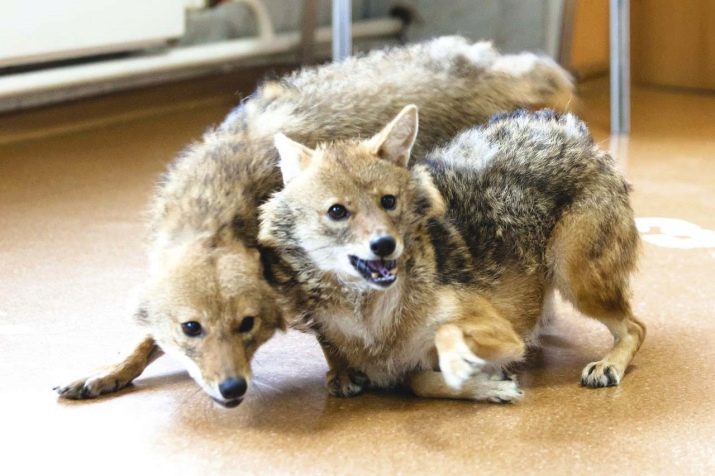
Thanks to the instinctive and omnivorous nature of jackal genes, quarters are able to recognize even the smallest traces of herbal drugs, as well as synthetic drugs. This makes breed representatives universal bloodhounds aimed specifically at the search for prohibited substances. Currently, more than four dozen huts working in the field of aviation security at various airports in the country.

They sniff everything - luggage on baggage belts, check-in and waiting rooms, compartments of the plane, people and objects.
Description
The hut is medium in size, its muscles are well developed, and its legs are strong. The ears are pointed at the ends, similar to the ears of a wolf, always in a standing position. The eyes are small, brown with a hint of amber, the nose is bright black. Sulimov’s dogs have a thick, coarse coat that perfectly protects them from frost and winds, with a thick undercoat. The coat may be semi-long or short. The tail is of considerable thickness and very fluffy, it can either twist in a ring or hang. There may be tows on the hind legs and tail, as well as in the collar area.

Quarteron heads are medium in size and wedge-shaped. All parts of the dog’s body are proportional to each other. The muzzle is narrowing to the nose. Lips are slightly pigmented and tight. Not wet. Quarterons have excellent teeth, white and strong, with a scissor bite. Paws are dry, directly set.

Dogs have excellent body balancing - they can land on their paws by jumping from a great height. This is the only dog breed that, falling from the fifth floor, can get off with minor injuries. Dogs are very mobile due to their small size, they can examine literally every centimeter of the working area.

The maximum weight of the hut is 15 kg, they reach a height of 45 cm, rarely 50.
Character
Shalayki have a complex character. Since in each of them there are jackal genes, they are not faithful and not attached to the owner. This is right, because shalayks were not “conceived” as companions and pets, in principle, their task is to serve for the good of the state’s security, and they fulfill it perfectly.
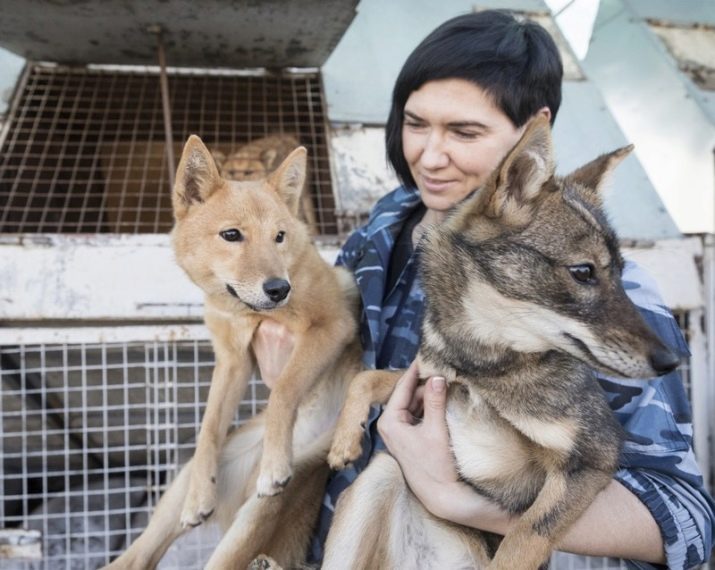
With people, the huts are careful, restrained. Sulimov’s dog is far less friendly and affectionate for the owner than her ancestor, the reindeer herding Nenets husky, she’s willful and independent.

Shalayks do not favor other dogs, except for representatives of their breed, and they can even help them.
The genetic memory of the quarters keeps not only the fear of people with the jackal, but also the fearfulness of the reindeer race. They were shot for many years in the tundra, so when they see a man with a gun or stick, they can "pass". Such dogs are not taken to work in the hall, but they work in laboratories.Most huts prefer to withstand suspicious people a distance of 40 steps - the distance of a shot.
Sulimov’s dog is fearless, brave, active. Their mobility and energy requires constant physical activity. Shalayka puppies are unusually smart, they love to play, but when they grow up, they lose this quality, acquiring seriousness and severity.

To date, these dogs are bred in only one kennel in Russia and are not available for purchase. This is not bad, as shaliks are not suitable for being pets.
The life expectancy of a hut is 14 years, they retire at 12. After leaving the service dogs attach to the new owners. It is impossible to buy a puppy, you can only buy a dog of retirement age or not passed the certification procedure. All dogs of this breed are the property of airlines; they are not sold either to other countries or to private owners, with the exception of those listed above.

The cost of the dog is unknown, there is only information that it is very high.
Also, it is known from dog handlers who train quarterons that due to the unique sharpness of the sense of smell of animals, a large number of orders were received from other countries, but there are no plans to sell them anywhere except Russia. Shalayki traveled many times outside of Russia on business trips, where they proved themselves to be the best. They also collaborate not only with Aeroflot, but also with the police. Their scent is really unique - in a trial test the dog makes a mistake once in two hundred.
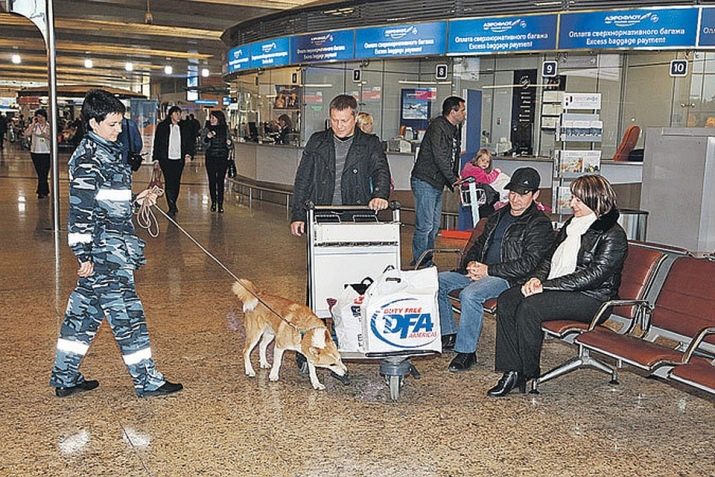
They can even understand whether a man or woman is in front of them, just by smelling a man!
Types of color
Quarteron can have different types of color - from one-color to two-and even three-color, including zoning.
Mostly brown huts with white spots on the chest. No less common black and white, piebald color. Thanks to the pinto, multicolor, the animal remains visible even in twilight and darkness.

Parenting
Representatives of the breed are well trained, understand the team the first time, are interested in new skills. The main incentive for them is to receive refreshments at the end of the lesson. But to the approval of the owner or dog handler, the huts are completely indifferent. Representatives of the breed have a powerful intelligence comparable to German shepherds. From this fact, we can draw an independent conclusion about their learning ability.

Aggression and physical abuse are unacceptable when raising a dog. It is necessary to set a task for the hut, to explain it as clearly and precisely as possible. If the dog performs a task, she is entitled to a treat. But flaunting superiority and asserting oneself in front of it is not necessary, in the case of a representative of this breed it is useless. She will not respond to this, nor to signs of love, affection and devotion.
Although the staff of the kennel noted that dogs are very attached to their trainers and partners, they can even lick or crawl into their hands.
Parenting and training of puppies starts from 8-10 weeks. They are kept separately from adult dogs, after a certain time a leader stands out in the group of puppies. First of all, attention is paid to him, and other puppies take an example from him. Employees of Aeroflot Nursery do not apply to the intricacies of their work with quarter-tones.

What to feed?
The diet of quarters should be rich in meat (approximately 4/5), twice a week you can replace it with fish. Be sure to feed the dog with cereals, fruits and vegetables. It is necessary to ensure constant access of dogs to clean drinking water.



The jackal’s omnivorous nature allows shalayks to be unpretentious in food, however modern dogs need a more balanced diet than before. Nenets reindeer racers mainly feed on fish, and quarterwaters also respect it very much. But, when offering a dog fish or meat, care should be taken to ensure that they do not have bones.

Fish bone is a great way to choke, and meat bone can damage a dog’s mouth.
How to care?
The necessary care for the representatives of the breed is minimal, the main one is combing the wool during the molting period. Events required for all breeds are anthelmintic treatment once a season, antiparasitic treatment and treatment with special compounds during tick activity.
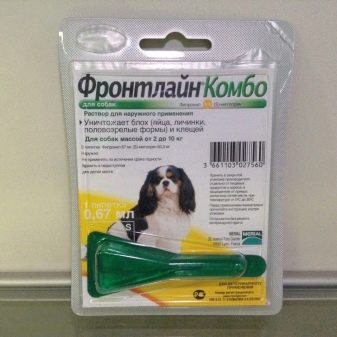

Unpleasant sensations in the quarters are clipping, so it is better not to do it. Long claws do no harm to this breed, and besides, they have the ability to grind on their own. Bathing is necessary in case of severe pollution, these dogs have no problems with water. If the dog is dirty, it smells specific. Representatives of the breed can swim on their own, they love water and swim well. The Quarterons immunity is excellent, they are not afraid of either frost or heat.
They are not susceptible to genetic diseases. Timely vaccination will help to avoid infections.
In the nursery, shaliks live in small enclosures. But they are not there for so long, because they have a rather long working day - 12 hours. Nurseries have 3 floors.

It must be borne in mind that breeding continues, the work of dog handlers and Sulimov himself, who has devoted more than 40 years of his life to shaliks, goes forward, and perhaps even more unique dogs are waiting for us in the future.

In the next video, everything is about a hut dog breed.





